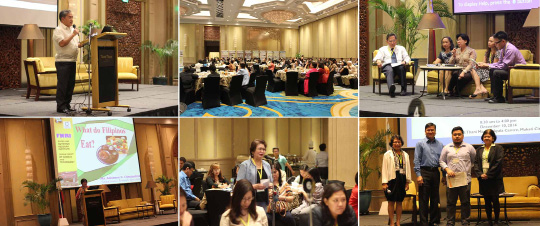National Nutrition Summit Part 2 at the Dusit Thani Hotel, Manila on December 10, 2014.
The latest Food Consumption Survey (FCS) by the Food and Nutrition Research Institute of the Department of Science and Technology (FNRI-DOST) in 2013 showed that 69.3 percent or about 7 in 10 Filipino households do not meet their dietary energy requirement. This was 2.4 percent higher than the 2008 survey results, as presented during the National Nutrition Summit Part 2, Dusit Thani Hotel, Manila last December 10, 2014.
The FCS is one of the components of the 8th National Nutrition Survey done every five years. The survey assesses the current food consumption situation and energy and nutrient intakes of Filipinos.
The mean one-day per capita or average daily individual food intake was 855 grams. This comprised mostly of rice, fish and vegetables. Over the last 10 years, the mean one-day per capita food intake has been on a down trend from 886 grams in 2003 to 855 grams in 2013.
The top 20 commonly consumed foods of Filipinos did not change, except for the rankings. The top five most commonly consumed foods were rice, salt, cooking oil, coffee and bread. People living in urban areas had higher intakes of total food, fats and oils, meat and products, poultry, milk and products, eggs, fruits and miscellaneous items than rural residents. In contrast, those living in the rural areas had higher intakes of cereals and products, starchy roots and tubers, fish and products, and vegetables than urban residents. The survey further revealed that only 62.7 percent of the households met their daily dietary protein requirement. What is alarming were the mean one-day per capita nutrient intakes for iron and calcium, where only 8.7 percent and 15.2 percent of households met the estimated average requirement (EAR), respectively.
Moreover, the proportion of households meeting the EAR was also low for vitamin A at 25.0 percent, riboflavin at 21.7 percent, vitamin C at 32.9 percent, and thiamin at 35.1 percent. The survey also assessed the food wastage of Filipino households. Data revealed that about 14.0 grams or about one tablespoon of rice, corn and products were wasted. This was a slight increase in platewaste from the 2008 survey particularly for rice, corn and products especially among rural households. Plate waste is defined as the edible portions of food which are left on the dining table or in the plates after the family has finished eating and are usually given to pets or discarded.
The results of the survey suggest that the country will not be able to meet the goal of decreasing by half the proportion of households not meeting their dietary energy intake by 2015. More in-depth analysis on the distribution of food among the population, as well as the evaluation of food-related programs that address inadequacy of intake among households are needed.











